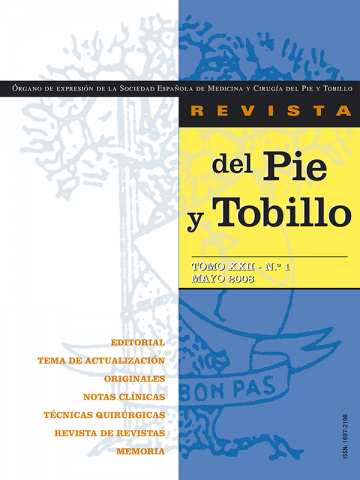Resumen:
Las fracturas de astrágalo representan el 0,4% de las fracturas del esqueleto y son las segundas en frecuencia del tarso. En su tratamiento es importante conocer la anatomía y el aporte vascular, así como sus secuelas, principalmente la necrosis avascular.
Se revisan 46 pacientes con 48 fracturas tratadas en nuestro centro entre los años 1996 y 2005. En 16 se ha realizado tratamiento ortopédico, y en 32, osteosíntesis. Analizamos la edad, sexo, mecanismo lesional, tipo de fractura, lateralidad, lesiones asociadas, tratamiento realizado y los resultados obtenidos según la escala de valoración AOFAS para lesiones de retropié y análisis estadístico mediante SPSS 15.0. Se realiza valoración radiológica. Seguimiento de 12 a 120 meses.
Los resultados obtenidos, teniendo en cuenta el tipo de paciente (medio laboral), son aceptables. En la escala de valoración AOFAS se han obtenido 18 resultados excelentes, 11 buenos, 12 regulares y 6 malos. Hubo un caso de amputación.
El riesgo de necrosis avascular aumenta con el grado de fractura- luxación. El signo de Hawkins es relativamente fiable para predecir la viabilidad del astrágalo. Es importante reducir anatómicamente estas lesiones para disminuir el riesgo de necrosis y la aparición de artrosis. Las complicaciones aparecidas condicionan el resultado funcional de estas fracturas.
Abstract:
Talus fractures represent 0,4% of all bone fractures and they are second in frequency among tarsal bones. A complete knowledge of the anatomy is very important on managing and evaluating the risk of avascular necrosis.
We have reviewed 46 patients with 48 talus fractures treated at our hospital between 1996 and 2005. Sixteen fractures were managed orthopaedically, and 32 surgically. The age, gender, mechanism, type of fracture, associated injuries, therapy and functional results in AOFAS rating scale for hindfoot lesions were analyzed. We used SPSS 15.0 to perform statistical analysis. Examination included standard radiographs. Follow-up 12 to 120 months.
The results achieved, for patients in the labour environment, were acceptable. In the AOFAS rating scale we achieved 18 excellent results, 11 were good, 12 regular and 6 worse. One patient had an amputation.
The risk of avascular necrosis increases related with the grade of fracture luxation. The Hawkins sign is useful to predict the viability of the talus after a fracture. It is important to reduce anatomically these fractures to reduce the risk of avascular necrosis and osteoarthritis. The final result of these fractures is determined by the complications achieved.





